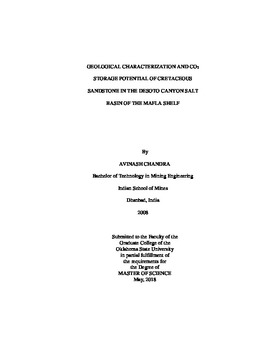| dc.contributor.advisor | Pashin, Jack C. | |
| dc.contributor.author | Chandra, Avinash | |
| dc.date.accessioned | 2019-05-08T18:36:52Z | |
| dc.date.available | 2019-05-08T18:36:52Z | |
| dc.date.issued | 2018-05-01 | |
| dc.identifier.uri | https://hdl.handle.net/11244/319626 | |
| dc.description.abstract | The southeastern U.S. constitutes more than 40% of anthropogenic CO2 emissions in the U.S., and most of this is emitted within 50 miles of the coast. Uniform government ownership, high capacity, and favorable source location indicate that the offshore continental shelf could be an attractive location for anthropogenic CO2 storage. This study focuses on understanding the depositional framework of the Cretaceous sandstone units in the Desoto Canyon Salt Basin in the Destin Dome, Mobile, Pensacola and Viosca Knoll Areas offshore of Mississippi, Alabama, and the Florida Panhandle and understand their potential for CO2 storage. Detailed analysis of geophysical well logs indicate that sandstone of the Paluxy Formation (Lower Cretaceous) and the lower Tuscaloosa Group (Upper Cretaceous) are the principal Cretaceous targets for CO2 storage in the study area. Target reservoir units in the Paluxy Formation are sealed by shale and limestone of the Washita-Fredericksburg interval, and those in the lower Tuscaloosa Group are sealed by a thick succession of Upper Cretaceous shale and chalk, as well as the overlying Paleogene mudrock successions. | |
| dc.description.abstract | The Paluxy Formation is a thick (>1,100 ft) progradational package of interbedded sandstone and mudstone that was deposited primarily by aggradation, apparently in coastal plain and shore-zone environments. The basal Washita-Fredericksburg interval (>1,000 ft) is predominantly limestone which passes upward into interbedded sandstone and mudstone resembling that in the Paluxy Formation. The lower Tuscaloosa Group contains the Massive sand (100-350 ft), which was deposited primarily as coastal deposits. Geophysical well log analysis reveals that while the lower Tuscaloosa and Paluxy sandstone are quartzose, thick (>120 feet), and generally possess high porosity (~18-21%), the reservoirs in the Washita-Fredericksburg interval have modest thickness (<60 ft). | |
| dc.description.abstract | Volumetric estimation of the storage resource in the reservoir units confirms Gt-class capacity in the nearshore part of the study area, where well control provides adequate volumetric constraint. The combined storage potential of the Cretaceous sandstone units is 28 Gt. Due to minimal seal and reservoir integrity risks, close well control, and thickest net sandstone (2.9 Mt/km2), the stable shelf of Mobile and Viosca Knoll Areas has been identified as the optimal injection location. Each offshore block in this area is capable of sequestering annual emissions from 13 major power plants (~5 Mt/yr). Detailed understanding of reservoir architecture and depositional environment will help select field-scale commercialization strategies such as multi-zone, single-zone and directional injection of anthropogenic CO2 to maximize the available potential. | |
| dc.format | application/pdf | |
| dc.language | en_US | |
| dc.rights | Copyright is held by the author who has granted the Oklahoma State University Library the non-exclusive right to share this material in its institutional repository. Contact Digital Library Services at lib-dls@okstate.edu or 405-744-9161 for the permission policy on the use, reproduction or distribution of this material. | |
| dc.title | Geological Characterization and CO2 Storage Potential of Cretaceous Sandstone in the Desoto Canyon Salt Basin of the Mafla Shelf | |
| dc.contributor.committeeMember | Puckette, James O. | |
| dc.contributor.committeeMember | Ismail, Ahmed Mahmoud Ali | |
| osu.filename | Chandra_okstate_0664M_15792.pdf | |
| osu.accesstype | Open Access | |
| dc.description.department | Geology | |
| dc.type.genre | Thesis | |
| dc.type.material | Text | |
